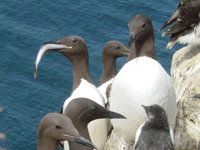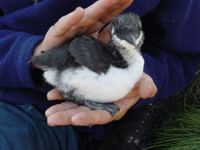
Seabird Oiling and By-Catch
Scientific Research on Triangle Island

Recent analyses indicate that the Common Murre is one of the species most often killed as a result of fisheries bycatch and chronic oiling in waters off the British Columbia coast. This has raised concerns about the population-level effects of this mortality, still basically unquantified, on murres in the P&Y Region. And we know that numbers in neighbouring Washington State have been declining for at least the last decade, with high rates of bycatch possibly contributing to the declines.
What is the population status of Common Murres at Triangle Island,
and elsewhere in BC?
And if the population is declining, is anthropogenic mortality
due to bycatch and/or oiling an important factor?
What have we found?

| Colony |
Survey Date
|
No. of Common Murres | Previous Estimate (year) |
| Kerouard Islands |
24 June 2004
|
377 | 400 (1987) |
| Triangle Island (total) |
2003, 2004
|
4327 | 5937 (1989) |
|
Southeast Point
|
18 Jul 2003
|
0 | 568 |
|
Puffin Rock
|
18 Jul 2003
|
4297 | 3370 |
|
Murre Rock
|
18 Jul 2003
|
30 | 987 |
|
Castle Rock
|
2003, 2004
|
0 | 1012 |
| Sartine Island |
9 Jul 2004
|
0 | 600 (1975) |
| Cleland Island |
6 Jul 2004
|
0 | 8 pairs (1975) |
| Florencia Island |
30 Jun 2004
|
0 | 1 pair (1969) |
| Starlight Reef |
30 Jun 2004
|
0 | 2 pairs (1980) |
| TOTAL | 4704 |